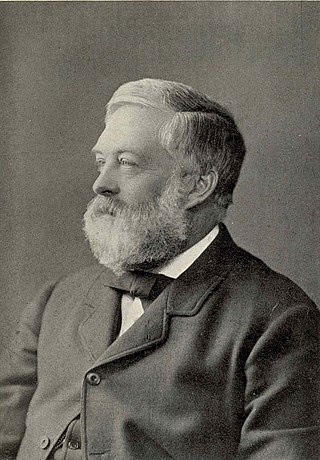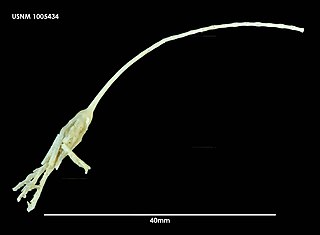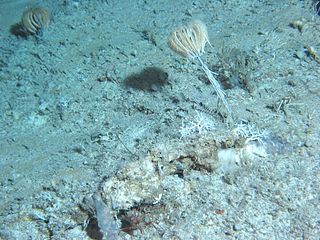
An echinoderm is any member of the phylum Echinodermata. The adults are recognisable by their radial symmetry, and include starfish, brittle stars, sea urchins, sand dollars, and sea cucumbers, as well as the sea lilies or "stone lilies". Adult echinoderms are found on the sea bed at every ocean depth, from the intertidal zone to the abyssal zone. The phylum contains about 7,000 living species, making it the second-largest grouping of deuterostomes, after the chordates. Echinoderms are the largest entirely marine phylum. The first definitive echinoderms appeared near the start of the Cambrian.

Crinoids are marine animals that make up the class Crinoidea. Crinoids that are attached to the sea bottom by a stalk in their adult form are commonly called sea lilies, while the unstalked forms, called feather stars or comatulids, are members of the largest crinoid order, Comatulida. Crinoids are echinoderms in the phylum Echinodermata, which also includes the starfish, brittle stars, sea urchins and sea cucumbers. They live in both shallow water and in depths as great as 9,000 meters (30,000 ft).

Sir Charles Wyville Thomson was a Scottish natural historian and marine zoologist. He served as the chief scientist on the Challenger expedition; his work there revolutionized oceanography and led to his being knighted.

The Rockall Trough is a deep-water bathymetric feature to the northwest of Scotland and Ireland, running roughly from southwest to northeast, flanked on the north by the Rockall Plateau and to the south by the Porcupine Seabight. At the northern end, the channel is bounded by the Wyville-Thomson Ridge, named after Charles Wyville Thomson, professor of zoology at the University of Edinburgh and driving force behind the Challenger Expedition. At the southern end, the trough opens into the Porcupine abyssal plain. The Rockall Basin is a large sedimentary basin that lies beneath the trough. Both are named after Rockall, a rocky islet lying 301.4 km west of St Kilda.

Admiral Pelham Aldrich was a Royal Navy officer and explorer, who became Admiral Superintendent of Portsmouth Docks.

Bathycrinidae is a family of echinoderms in the class Crinoidea. It contains the following genera and species:

Comatulida is an order of crinoids. Members of this order are known as feather stars and mostly do not have a stalk as adults. The oral surface with the mouth is facing upwards and is surrounded by five, often divided rays with feathery pinnules. Comatulids live on the seabed and on reefs in tropical and temperate waters.

Davidaster rubiginosus or the orange sea lily is a species of crinoid in the family Comatulidae. At one time it was classified as Nemaster rubiginosa but the World Register of Marine Species has determined that the valid name is Davidaster rubiginosus. It is found on reefs in the tropical western Atlantic and the Caribbean Sea.

Bourgueticrinida is an order of crinoids that typically live deep in the ocean. Members of this order are attached to the seabed by a slender stalk and are known as sea lilies. While other groups of crinoids flourished during the Permian, bourgueticrinids along with other extant orders did not appear until the Triassic, following a mass extinction event in which nearly all crinoids died out.
Bathycrinus aldrichianus is a species of sea lily, a crinoid in the family Bathycrinidae. It is native to deep water in the North Atlantic Ocean. It was first described by the Scottish marine zoologist Charles Wyville Thomson and named in honour of Pelham Aldrich, a British naval officer and explorer. It is believed to be the crinoid living at the greatest depth.

Beroe cucumis is a species of comb jelly in the family Beroidae. It is found in the Atlantic Ocean. It was first described by the Danish missionary and naturalist Otto Fabricius in 1780.

Bathycrinus australis is a species of sea lily, a crinoid in the family Bathycrinidae. It is native to deep water in the Antarctic Ocean. It was initially identified as Bathycrinus aldrichianus by Philip Herbert Carpenter following the 1872-1876 HMS Challenger expedition. It was later distinguished as a new species by the American zoologist Austin Hobart Clark.
Bathycrinus australocrucis is a species of sea lily, a crinoid in the family Bathycrinidae. It is native to the New Zealand region. It was described by D. G. McKnight.
Bathycrinus carpenterii is a species of sea lily, a crinoid in the family Bathycrinidae. It is native to the North Atlantic. It was described by Danielssen & Koren.
Bathycrinus mendeleevi is a species of sea lily, a crinoid in the family Bathycrinidae. It is native to the Pacific Ocean west of South America. It was described by A. N. Mironov.

Bathycrinus is a genus of crinoids.
Callogorgia is a genus of deep sea corals that are ideally suited to be habitats for different organisms. They reproduce both sexually and asexually, clinging to the hard substrate of the ocean during their maturation process. Callogorgia are found at depths ranging from 750-8200 feet in the Gulf of Mexico, Pacific Ocean and the Caribbean Sea. An array of organisms have relationships with Callogorgia, including brittle stars, cat sharks, and copepods. The nature of these relationships are often commensal, with Callogorgia providing a habitat for the organisms.

Endoxocrinus parrae is a species of stalked crinoids of the family Isselicrinidae. It is the most commonly found isocrinine species in west Atlantic Ocean.
Beroe gracilis is a species of comb jelly in the family Beroidae. It is a free-swimming species found in the North Sea, the Atlantic Ocean and the Mediterranean Sea.
Lycodes gracilis, Vahl's eelpout or the gracile eelpout, is a species of marine ray-finned fish belonging to the family Zoarcidae, the eelpouts. It is found in the eastern North Atlantic Ocean and adjacent areas of the Arctic Ocean.













